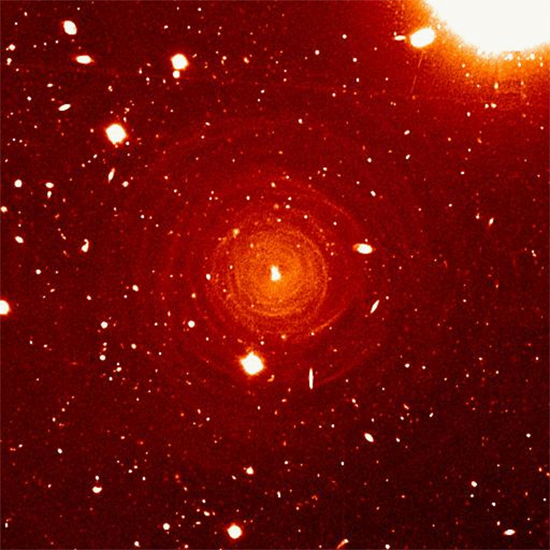|

So-called "carbon star" IRC+10216.
Credit: Izan Leao (Universidade
Federal do Rio Grande do Norte,
Brazil).
Damp Stars
Mar
30, 2011
Some stars are said to be
surrounded by haloes of hot water
mixed with carbon dust.
According to a recent European Space
Agency (ESA)
press release, the
Herschel infrared space
observatory discovered a
cloud of hot water surrounding a
giant star in constellation Leo
known as IRC+10216. Space scientists
were puzzled by the discovery of
water near other carbon stars, but
the Herschel team thinks they know
what creates it: ultraviolet light.
As the ESA bulletin states, "It
is the only explanation for why a
dying star is surrounded by a
gigantic cloud of hot water vapour."
Supposedly, ultraviolet light from
nearby stars penetrates the envelope
between gaseous "clumps," breaking
apart carbon monoxide and silicon
monoxide, allowing oxygen and
hydrogen atoms to attach, forming
water.
IRC+10216 is a red giant star,
surrounded by a massive cloud of
dust that absorbs most visible
light. The only way to "see through"
the dust barrier is with infrared
detectors. It is in that dust that
the water vapour was found. The
"clumpy structure" in the dust
around the star is said to
contribute to the formation of the
water.
In an Electric Universe, stars
are electromagnetically and
externally powered. A star is the
locus of electric currents that
circulate through the galaxy along
star-spanning filaments known as
Birkeland currents. A
red giant is a star
lacking a photosphere, the "surface"
from which main sequence stars emit
radiation. In the case of IRC+10216,
its chromosphere has expanded in
order to meet the red giant’s
electrical needs.
Stars shine because electricity
flows through each galaxy. As has
been written in these pages many
times, stars can be thought of as
giant spheres of slow-motion
lightning. It is this simple
hypothesis that best matches
observational evidence. Any fusion
takes place on the surface of an
electric star and not "deep in its
core." Molecular oxygen can be
created in electrically intense
outer layers of a star. The primary
indicator for a star's behavior is
the current density at its surface.
Stars do not rely on internally
generated fusion fires to supply
them with energy.
Electric Universe advocate
Wal Thornhill writes:
“Red stars are those stars that
cannot satisfy their hunger for
electrons from the surrounding
plasma. So the star expands the
surface area over which it collects
electrons by growing a large plasma
sheath that becomes the effective
collecting area of the stellar anode
in space. The growth process is
self-limiting because, as the sheath
expands, its electric field will
grow stronger. Electrons caught up
in the field are accelerated to
ever-greater energies. Before long,
they become energetic enough to
excite neutral particles they chance
to collide with, and the huge sheath
takes on a uniform ‘red anode glow.’
It becomes a red giant star."
A relatively cool atmosphere
exists beneath the chromosphere of a
red giant, so larger and more
complex molecules can exist there.
The molecular oxygen and the carbon
atoms around IRC+10216 are created
in the star's atmosphere because an
electric field accelerates electrons
toward the star. This flow of
electrons is balanced by a flow of
positive ions radiating in the
opposite direction. Electric stars
form by Marklund convection, so they
do not possess cores of compressed
hydrogen. Heavy elements, including
carbon, collect in their cores.
Relying on the remote ultraviolet
emanations from other stars
penetrating the obscuring clouds of
dust because they are "clumpy"
misses the point of electrical
activity there.
Stephen Smith
 New
DVD New
DVD
The Lightning-Scarred
Planet Mars
A video documentary that could
change everything you thought you
knew about ancient times and
symbols. In this second episode of
Symbols of an Alien Sky, David
Talbott takes the viewer on an
odyssey across the surface of Mars.
Exploring feature after feature of
the planet, he finds that only
electric arcs could produce the
observed patterns. The high
resolution images reveal massive
channels and gouges, great mounds,
and crater chains, none finding an
explanation in traditional geology,
but all matching the scars from
electric discharge experiments in
the laboratory. (Approximately 85
minutes)
Video Selections
Order Link
|





 New
DVD
New
DVD

